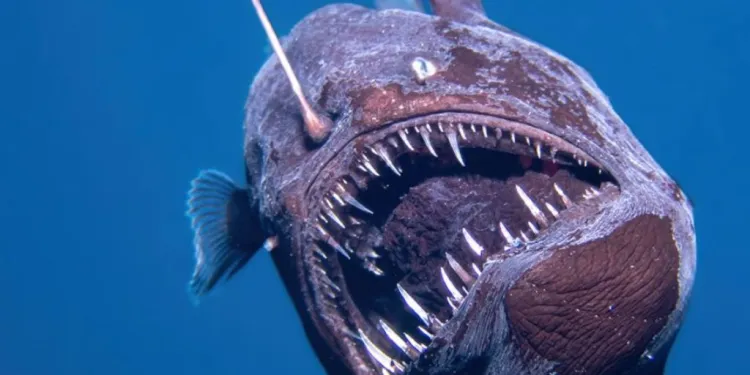Deep in the ocean’s depths, where light is scarce and life has developed incredible strategies to survive, dwells the Black Devil Fish (Melanocetus johnsonii). This abyssal creature, with its fearsome appearance and bioluminescence, has long captivated scientists and ocean enthusiasts alike. Popularized by the film Finding Nemo, this shadowy predator symbolizes the many mysteries of the sea.
What was once thought to be a creature confined to the dark depths has now made headlines in an unprecedented event: an adult specimen was spotted and filmed alive on the ocean’s surface, off the coast of Tenerife, in the Canary Islands.
An Unexpected Encounter with the Deep Sea Predator
The sighting occurred during an expedition led by the NGO Condrik-Tenerife, which specializes in studying pelagic sharks. Marine biologist Laia Valor was the first to notice the strange silhouette floating at the surface. The team, which included biologists Marc Martín and Antonio Sabuco, along with photographer David Jara, quickly documented the find with images never seen before.
Until now, all records of this species had been of larvae, dead specimens, or footage captured via submersible vehicles at depths of up to 2,000 meters. To see it in broad daylight has raised intriguing questions: what could have brought it to the surface?

A Shadow Hunter in Shallow Waters
The Black Devil Fish is a predator that uses its iconic glowing antenna to lure prey in the darkness of the ocean. In its natural habitat, between 200 and 2,000 meters deep, bioluminescence plays a crucial role in hunting and communication.
However, this time, the fish appeared in an entirely unusual environment. Hypotheses about its presence at the surface include the influence of upwelling currents, a disease affecting its swimming abilities, or even an escape from a predator.

Fun Facts About the Black Devil Fish
While its bioluminescence is striking, it’s actually a deadly feature. The glowing antenna, populated with symbiotic bacteria that generate light, serves as a biological lure, attracting prey directly into its mouth. Moreover, thanks to its massive jaws and the ability to expand its stomach, the Black Devil Fish can consume prey larger than its own body. Scary, right?
Another unique feature is its remarkable ability to adapt to extreme conditions. In the ocean’s depths, where resources are scarce, this fish has evolved to endure high pressures, frigid temperatures, and long periods without food.
Despite its intimidating appearance, the Black Devil Fish poses no threat to humans. What’s even more fascinating is its unusual mating strategy: in some species within the same family, males, much smaller than the females, literally merge with them. Their organs atrophy, becoming a simple reservoir for sperm, allowing the female to reproduce whenever she needs.

A Discovery That Raises New Questions
This encounter, recorded in the Network of Marine Observers in the Canary Islands (RedPROMAR), marks a milestone in marine biology. Beyond its rarity, this sighting underscores the importance of ocean exploration and the role of citizen science in uncovering the sea’s secrets.
The Condrik-Tenerife team is continuing its research to better understand the behavior of this fascinating fish and other deep-sea inhabitants. How many more mysteries await discovery in the ocean’s depths?




